The Art Lawyer’s Diary Sept
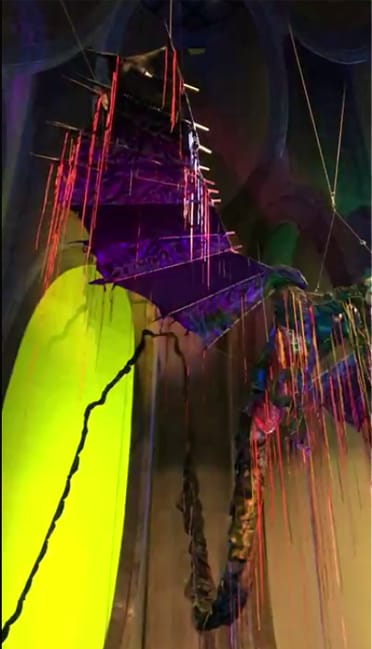
The Art Lawyer’s Diary 1
Out of Africa: Reflections on the Opening of Cape Town’s Zeitz MOCAA, the Joburg Art Scene and the Power of Ought
On Friday, September 22, the first public institution dedicated to contemporary art and the art of the diaspora in Africa, Cape Town’s Zeitz MOCAA, opened to a sold out weekend of more than 50,000 visitors, with 5,000 visitors per day since. Zeitz (not Zulu, Xhosa or even Afrikaans, but the name of its German founder) MOCAA’s aim is to represent and give voice to contemporary African artists from the continent and the diaspora to tell their own story. As Mark Coetzee, the South African director and chief curator explains: “the mission is to collect, preserve, research and exhibit cutting edge artifacts from the 21st century and subvert deeply entrenched stereotypes of African life and art.”
I was privileged to be included in the VIP preview week before the public opening. In part, because of my long-term involvement with Performa, the visual performance arts biennial. Performa 17’s focus is South Africa and our founding director, Roselee Goldberg, born in Durban, South Africa, is a Curator at Large for Performance at Zeitz MOCAA. I have a long time connection to Africa and passion for African art, which began with my participation as a student in Crossroads Africa in Niger and Tanzania, and continued, most recently with the founding of the first “Friends” organization for an African museum, the world class National Museum of Mali in Bamako, marvelously directed by Dr. Samuel Sibide, on what is now a shoe string budget.
South Africa, however, as I was growing up, was indelibly marked by our active protest and demonstrations in the US against Apartheid. My first case as a litigator when I graduated law school in 1972 was a case against the New York Times for publishing employment advertisements for employment in South Africa. We prevailed under New York City Human Rights Law, in our argument that by publishing such ads the New York Times was aiding and abetting race discrimination, on the theory that no black person could be hired in these executive positions for employment and that the term “South Africa” signified racial discrimination as the term “select clientele” signified anti-Semitism in the 1960’s in New York. Until 1994, the fact that black South Africans could not visit an art museum, paled next to the social and spatial engineering of Apartheid. Cape Town and other South African cities were conceived with a white-only center, surrounded by contained settlements for the black and colored, hemmed in by highways and buffer zones of factories and scrub. The military-style encampment townships sterilized any reference to community, a sense of cultural space, and indigenous culture and tradition.
It was therefore with enthusiasm that I welcomed the opportunity to visit and experience the current art scene in both Cape Town and Johannesburg. I was already well aware from my participation in the international art world of some of the amazing artists, represented by committed galleries like Goodman, coming out of South Africa from the 1990’s to now. I was interested to see how art and culture were establishing their place in a society which only twenty three years ago had ended Apartheid to adopt a multicultural constitution and eliminate white privilege as the fundamental basis for ordering society and distributing its benefits.
Zeitz MOCAA is housed in a converted grain silo in an urban redevelopment area on the Victoria and Alfred waterfront area. Designed brilliantly by English architect Thomas Heatherwick, the nine floors of gallery space were ostensibly paid for by the development of a boutique hotel which occupies the top six floors, and in a real estate deal between the South African Government Employees Pension Fund, Growthpoint, the country’s largest listed property development company, and Jochen Zeitz, former CEO of Puma. The current core of the collection is, somewhat problematically, on long term loan from its German patron Zeitz, who sits on the board of trustees of the non-profit public foundation museum board of seven trustees. Artists in his collection have also generously donated to the permanent collection. Consistent with its mission, the museum encompasses, in addition to the over one hundred galleries dedicated to the large cutting edge permanent collection and temporary exhibitions, Centres for Art Education, Curatorial Excellence, Performative Practice, Photography, the Moving Image, and the Costume Institute.
The collection was put together by Zeitz working with Coetzee from 2010 with an African museum in mind. The two met in connection with the Rubell Family Collection’s Miami Basel 2008 exhibition, “Thirty Americans”: Coetzee was the Rubell curator and Puma was the sponsor of the traveling exhibition. Thirty included prominent African American artists such as Glen Ligon, David Hammons and Jean Michael Basquiat, as well as then emerging African American artists such as Hank Willis Thomas, Kehinde Wiley, and Rashid Johnson. Many of these artists are included together with such high profile artists as Isaac Julien (Britain), William Kentridge (South Africa), El Anatsui (Ghana), Wangechi Mutu (Kenya), Ghada Amer (Egypt), and Chris Ofili (Britain) are included in Coetzee’s curated exhibition from the permanent collection, All Things Being Equal. The inaugural exhibition also includes a majority of South African artists, both established and emerging, such as Zanele Muholi, Sethembile Msezane, Mohau Modisakeng, Kendell Geers and Mary Sibande, but only features three from French speaking West Africa: Leonce Raphael Agbodjélou (Benin), Julien Sinzogan (Benin), and Owanto (Gabon).
Edson Chagas (Angola), Kudzanai Chiurai (Zimbabwe), Nandipho (South Africa), and Yinka Shonibare, MBE (United Kingdom) all have solo exhibitions. Edson Chagas’ Luanda, Encyclopedic City, a site-specific installation was originally exhibited in the Palazzo Cine when it was awarded the Golden Lion in Venice in 2015, as was Mutu’s work in 2015. Isaac Julien’s nine screen installation One Thousand Waves is beautifully installed in the second floor gallery. I first saw it at the Bass Museum in Miami in 2010, and Chiurai’s multimedia installation Conflict Resolution was exhibited in the 2012 edition of Documenta.
Opening night, hosted by Gucci, was a vibrant gathering of the South African and international art world with musical performances and visual artist performances by Namela Nyamza. Hanging above was a giant rubber flying bird by South African artist Nicholas Hlobo. In evoking the Xhosa myth of the Lightning Bird, Hlobo, a gay activist, reimagines it as a personal story that both honors and challenges traditional African notions of masculinity.
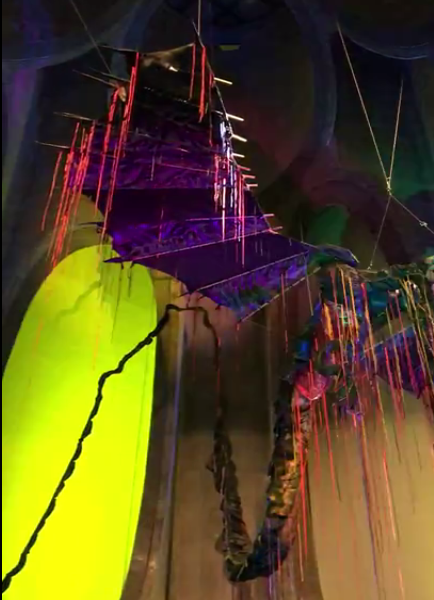
Opening night, Zeitz MOCAA. Video by author, Sept. 16, 2017.
Nandipha Mntambo was born in Mbabane, Swaziland in 1982. She graduated from the University of Cape Town in 2007. Her solo retrospective ” Material Value” (9/22-2018) presents works which address ongoing debates around traditional gender roles, body politics, identity and the liminal boundaries between human and animal, femininity and masculinity, attraction and repulsion, life and death. Her best known works are her figurative cowhide sculptures which allude to the symbiotic relationship between humans and nature; Zeitz owns approximately 70 of her works.
Nandipha Mntambo, Emabufto, © 2012. 120 x 60 x 20 cm (each). Cowhide, resin, polyester mesh and waxed cord. Photo by author, Sept. 16, 2017.
Sethembile Msezane, born in 1991, is a South African artist living and working in Cape Town. Working in performance, photography, and sculpture, Msezane maps out how the process of commemorative practice informs constructions of history, mythmaking, and ultimately addresses the absence of the black female body in the monumentalisation of public spaces.
Left: Sethembile Msezane stands before her sculpture entitled Kwasuka Sukela, © 2016. 66 x 47 cm. Cloth, hair, salt, and wood. Photo by author, Sept. 16, 2017.
Right: Sethembile Msezane, Gog’ Mashange, © 2016. 74 x 42.5 cm. Hair, metal, velvet, and wood. Photo by author, Sept. 16, 2017.
Kudzanai Chiurai‘s solo retrospective, Regarding the Ease of Others (9/22-3/31), presents a survey of his expansive oeuvre since 2006, which include posters, sculpture, photography, painting, print and video.
For Conflict Resolution, he combined a series of narrative mediums to make art accessible to a new generation of Africans – a group he says no one tries to talk to. “We are in a position where, as a born-free generation, we won’t be forgotten.”
“You can’t escape politics,” explains Chiurai, who stood up to Robert Mugabe. “Everything’s political in the sense like how we’re socialized.” Starting as a painter, after leaving Zimbabwe to study art in Pretoria (he was the first black graduate), he became active against Zimbabwe’s President, drawing comparisons to Ai WeiWei. I was totally mesmerized by the extraordinary and powerful Iyeza, a film addressing political corruption, war, abuse of power, reconstruction and solidarity. Chiurai’s work powerfully interrogates a contemporary African notion of sacrifice.
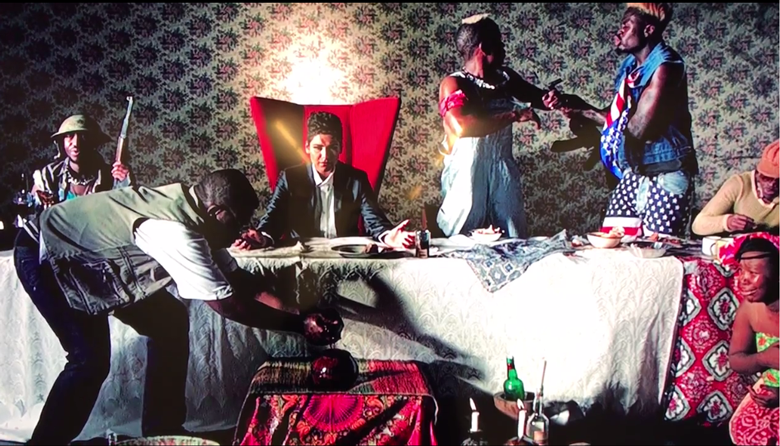
Kudzanai Chiurai, excerpt from IYEZA, © 2012. 11 minutes. Digital video (colour, sound). Video by author, Sept. 16, 2017.
Artist Wangechi Mutu (Kenya) and El Anatsui (Ghana) meet in front of Wangechi’s The End of Carrying All, shown at the Venice Biennale in 2015.
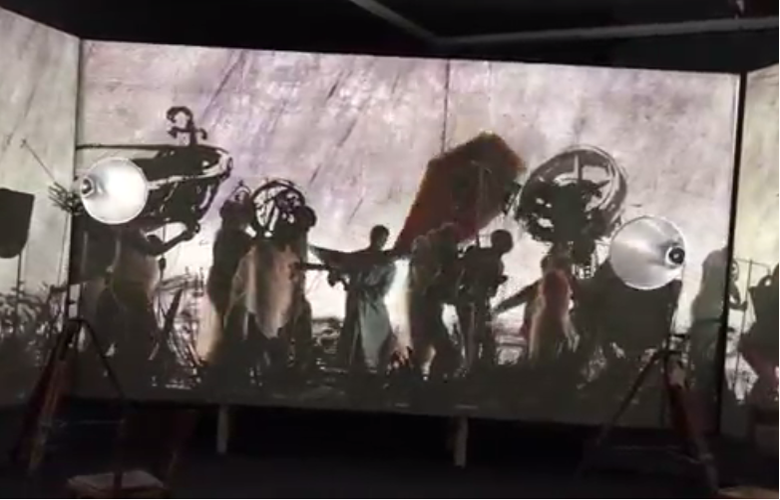
William Kentridge, More Sweetly Play the Dance, © 2017. Digital video installation (colour/sound). 15 min. Video by Author, Sept. 11, 2017.
Leonce Raphael Agbodjélou was born in Porto-Novo, Benin. Agbodjélou is best known for his photographs of the people of Porto-Novo, as in his ongoing series, Citizens of Porto-Novo, which attempts to document and capture a generation in the transition between tradition and progress.
In Egungun, the artist documents costumes that represent incarnations of the Yoruba tribe’s ancestral forebears, traditionally worn at processions and funerals. Trained by his father, a skilled and internationally renowned photographer, Agbodjélou’s choice of medium in combination with this form of traditional pageantry highlights the tension he attempts to capture in his work.
South Africa. In the background is Agbodjélou’s 2015 work entitled ” Egungun Masquerade VI” ©. Photo taken Sept. 16, 2017.
South African born Belgian artist Kendall Geers has always worked closely with his roots as an African Artist in an exorcism of identity, throwing his white African roots up against the wall of sociopolitical interrogation. Being both white and African, an artist living in exile, a freedom fighter who grew up in struggle again Apartheid, his work is difficult to define in singular terms, always layered with contradiction and contrast.
Kendell Geers’ installation entitled Hanging Piece is a double entendre: the word “piece” is both a colloquial term for a gun and a homonym of peace. The work is a conscious reference to a protest tactic employed by the anti-apartheid movement in which impoverished people living in the shacks by the freeways would hang heavy objects from freeway overpasses- when drivers, who were typically white and headed to their holiday vacations, would speed under the bridges they would collide with the rocks and bricks. The bricks would be become weapons, but the bricks would hang still; it was the velocity cars that made them dangerous. Geers’ installment is interactive, meant to be walked through and felt so that the hanging bricks “implicate your position in a greater community”, not only by causing your movements to be determined by the layers of bricks occupying the space you must navigate, but also by forcing you to be conscious of those around you- if you were to navigate the installment without a certain sense of self-awareness, you could easily cause a brick to hit the person behind you or you might be slammed by a brick yourself.
Geers provides further insight into his complex and contradictory installation, explaining that; “in itself, the clay brick is nothing more than fired earth and yet at the same time charged with connotation, allusion and symbolism. In a museum or gallery it obviously quoted Carl Andre but at the same time, it was also a powerful political symbol representing the aspirations of millions of homeless black South Africans living in shantytown shacks that would blow down with every storm. In the hands of a young militant it was a missile to be thrown in the faces of the white establishment whereas in a gallery or museum it was an icon of the Avant Garde.”
Kendell Geers, Hanging Piece, © 1993. Bricks and rope. Dimensions variable. Photo by author, Sept. 16, 2017.
This is a spectacular debut for Zeitz MOCAA, certain to earn approval of collectors, tourists and locals lucky enough to visit. It should be a detour for any visitor to Southern or East Africa and a destination for the rest of us. Precisely because of Zeitz MOCAA’s importance and uniqueness on the continent, certain issues, otherwise dismissed, are appropriately the subject for dialogue and discussion.
Some critics have talked of conflicts of interest or lack of diversity in board representation. The fact that a director is also the chief curator is not by virtue of that position a conflict. The highly regarded Thelma Golden occupies both positions at the Studio Museum of Harlem. More problematic is the involvement of collectors and dealers on a board. Whilst US museums tend to prohibit dealers, collectors are the core of most boards, and are subject by the IRS to sign yearly conflict of interest policies. To my knowledge there are no dealers on the Zeitz MOCAA board. Notwithstanding the number of writers who have referred to the board of trustees as all white, my research indicates that in addition to David Green and Jochen Zeitz, the current Board of Trustees is made up of the following individuals: Wangechi Mutu and Isaac Julien, Gassant Orrie, a respected corporate lawyer from Cape Town, Albie Sachs, retired judge of the Constitutional Court and one of South Africa’s heros of the African National Congress, and Suzanne Ackerman-Berman, a distinguished Cape Town collector, philanthropist and social entrepreneur. It is a small board for a public institution by US standards and really not inclusive if its intention is to represent the entire continent and the diaspora. On the other hand, major US museums have received similar criticism: for example, the 50 some odd trustees of the Whitney include only three African Americans, one of whom, Fred Wilson, is also the only artist.
A model more akin to the Smithsonian with advisory boards for each of the areas of collecting and geographic representation may be desirable in a few years. The current collection of Zeitz is inspired by the Rubell Collection’s model, and although this institution is public, some of the same concerns may be raised, even more so for a public institution, given the fact that the majority of artworks are on long term loan until Zeitz’s death or twenty years, whichever is longer.
The Rubell Collection has been criticized for its policy of exhibiting only works from its collection because it limits the potential breadth of its shows, which in turn restricts their critical depth. In addition, the Rubells’ position as taste-setters and market-shapers can lead to the neglect of significant contemporary artists. Hopefully, this is not the case with Zeitz MOCAA, as already indicated by a number of loans for the various solo exhibitions.
A second and perhaps more fundamental concern is the stated limiting criteria of “21st Century” and “cutting edge” to define the African voices which are to be given a platform. Such rigid separation of the “cutting edge contemporary” from traditional African art may be a Eurocentric construct; what is African art from the viewpoint of an African artist and a twenty first century African?
Kendell Geers makes the astute observation that “the history of African Art is intertwined within the context of its contradictory histories, the complexities of its politics, identities, communities, struggles and culture in general. The AK47 is as integral to African identity as the mask, wax print fabric and mobile phone and yet these incongruous elements are rarely understood as inextricably connected.”
According to him, it was Picasso, more than any other European artist, who first understood the power of African Art after a visit to the Trocadero Museum in Paris in 1907. Contrary to the widely held assumption, he was not looking at historical masterpieces, but at masks and power objects made by his African contemporaries a few years prior. Andre Malraux quotes Picasso: “I understood something very important: something was happening to me. The masks weren’t like other kinds of sculpture. Not at all. They were magical things.” The artists exhibited at Zeitz MOCAA have not rejected the traditional African art: as Geers puts it, “African art continues to fascinate artists who collect, curate and are inspired by the liberating forms of tradition that continues to hold spirit as the force that binds aesthetics to form.”
I experienced a vital contemporary art scene in emerging areas gentrifying parts of Cape Town, like Woodstock and Maitland. The number of contemporary galleries in Cape Town with engaging exhibitions and programs during the preopening festivities of Zeitz MOCAA was in process. Gallery Night, which preceded Zeitz’s opening, included performances and exhibitions at the A4 Arts Foundation, Blank Projects, Goodman Gallery, Gallery MOMO, SMAC Gallery, Stevenson Gallery, and Whatiftheworld Gallery, and featured special performances and exhibitions by many artists, including Turiya Magadlela, Bronwyn Katz, Herman Mbamba, Kutala Chopeto, Grada Kilomba, Sethembile Msezane, Lhola Amira, Mongezi Ncaphayi Cyrus Kabiru, Lyle Ashton Harris, Zanele Muholi, Mohau Modisakeng. I could even walk around the emerging artistic areas in Cape Town which is not necessarily the case with Joburg.
Working in performance, sculpture, installation, video, and large-format photography, Mohau Modisakeng explores issues surrounding the history of the black body within the socio-economic and political contexts of South Africa’s violent and oppressive past.
Modisakeng’s live performance was based on Passage (2017), a three-channel video projection and photographic series that meditates on slavery’s dismemberment of African identity and its enduring erasure of personal histories. In the gallery performance, a pool of water gradually forms beneath their bodies. The rising water gradually floods the well of the boat eventually leaving the passengers submerged while the boat is slowly sinking and eventually disappearing. Passage (2017) was commissioned by the South African Department of Arts and Culture on the occasion of the 57th Art Exhibition – la Biennale di Venezia, which I discussed in my review of the Venice Biennale for 1 Art Nation 2.
Mohau Modisakeng, still from Passage (2017), Zeitz MOCAA, 2017. Photo by author, Sept. 9, 2017
From Crocodile Lover, a lecture and performance by Kutala Chopeto featured at the Goodman Gallery Artist’s Brunch, Sept. 15, 2017. Photo by author.
Lyle Ashton Harris and Zenele Muholi at The Stevenson Gallery’s Breakfast Show, moderated by Mark Gevisser who sits between the two artists (Harris on the left, Muholi on the right) in the photograph on the left. Photos courtesy of Stevenson, Cape Town and Johannesburg.
“We must recognize the power of the ‘ought’. It’s the power to change the world! We can’t just see the world in terms of how it is today, or we will always feel defeated. But when we see the world in terms of how things ought to be, we can dream for the impossible – and work to see it become reality.” – Max Kampelman
Khayelitsha is a township in Western Cape, South Africa, located on the Cape Flats in the City of Cape Town. It is the largest and fastest growing township in South Africa, originally established as an “apartheid dumping ground” in the mid 80’s as a part of the “Group Areas Act”. In the last ten years the population has risen from 400,000 to 2.4 million, 50% of which are under 19 years of age. Unemployment rate is 73%, with 70% living in shacks. 89% of homes are considered moderately to severely food insecure. The extreme poverty, coupled with poor community infrastructure, lead to immense crime rates, gangs, violence, drugs as well as other societal ills.
Juma Mkwela, a popular street artist and tour guide in Khayelitsha, is currently involved in a project in the township which attempts to create positive, sustainable change by gardening and creating art in the streets of Khayelitsha.
Above: paintings on building walls in the Khayelitsha township of Western Cape, Cape Town. The artwork is part of a project to bring art and art education to the townships and headed up by Juma Mkwela, photographed above. Photo by author, Sept. 15, 2017.
Recent attempts at gentrification have resulted in the displacement of all the residents there to tented camps. Johannesburg’s racial segregation and central business district of squatter housing abandoned by legal residents at the time of Apartheid sanctions and white flight in 1994 is as disquieting as the armed security guards and ADT shoot to kill signs in the wealthy neighborhoods such as Houghton.
On the left, a Houghton home walled in by barbed wire and a security guard station; on the right, an outside view of one of Johannesburg’s squatter apartment complexes. Photos by author, Sept. 10, 2017.
Goodman Gallery did tremendous social media outreach to ensure that their public events and installations were genuinely accessible to the public and not just art world elites. When I attended Kudzanai Chiurai’s We Live in Silence on Constitution Hill, I found myself in conversations with many audience members from Johannesburg: a doctor who served migrants and heard about the performance on social media and several young hipsters who were there for the music and free drinks; in other words, many were the born free generation members that Chiurai’s art addresses, his intended audience. Chiurai himself lives in central Johannesburg. Like Zanele Muholi, whose work is her activism and activism is her work, both South African artists’ visionary photographs and videos simultaneously confront the realities they are dealing with now while creating fantastical alternative ones.
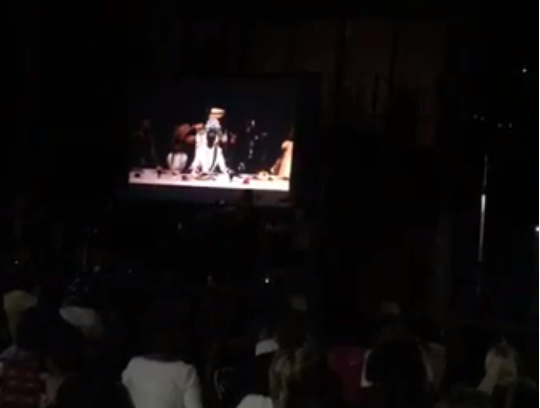
Audience members watch Kudzanai Chiurai’s video performance We Live in Silence at Constitutional Court in Johannesburg. Video by author, Sept. 9, 2017.
The FNB Joburg Art Fair is in its 10th year and is focused on contemporary art from the African continent and diaspora, featuring 60 exhibitions. The degree of outreach in the Joburg Art Week and engagement with townships like Soweto was meaningful. The Joburg Art Fair was small but highly engaging and seemed to truly be a platform for contemporary artists and galleries to engage in dialogue.
The Johannesburg Art Fair, 2017. Photo by author, Sept. 9, 2017.
Peju Alatise won the Johannesburg Art Fair’s FNB prize for her new installation entitled o is the new +, a work which employs the potent imagery of tires in connection to mob violence and lynching. Her symbolism, like Geers’ use of bricks, Mntambo’s use of cow hides, or even Anne Imhof’s placement of German Shepherds caged at the entrance of her German Pavilion’s Faust at the 2017 Venice Biennale, packs a powerful political punch and reminds us of the friction between the way things are and the way they ought to be.
Peju Alatise, o is the new +, 2017. Dimensions vary. Johannesburg Art Fair, Johannesburg. Photo by author, Sept. 9, 2017.
David Koloane was instrumental in establishing studio space for black artists at The Fordsburg Artists’ Studios (The Bag Factory) and he founded the Thupelo Workshops in South Africa, a concept that spread to Botswana, Mozambique, Zimbabwe and Namibia. The Bag Factory founded in 1991 became the studio space which made it possible for black and white artists to work together on a professional level, despite the Apartheid legislation of that time.
David Koloane, left, discusses his work in an interview conducted at his Bag Factory Studio. Photo by author, Sept. 9, 2017.
One of the most meaningful events that I attended was the performance at William Kentridge‘s Center for the Less Good Idea, “an interdisciplinary incubator space for the arts based in Maboneng.”
The Maboneng district and Arts on Main has everything you might expect in the world of the hipster – cafes, bars in warehouses, al fresco restaurants, clothing stores. In the few concentrated streets that make up the area. The blocks around it, though, are yet to be touched. Homeless people sit in doorways, a fire burns in a metal drum, barbed wire surrounds the entrances to a derelict building, abandoned cars sit in the gutter, bodies lie under trees in a barren park. The emergence of transportation in the form of Uber is helping to make life in the evening a possibility in these areas which are far from safe at least from the perspective of an outsider.
The Centre for the Less Good Idea hopes to create an environment in which artists are driving the ideas and setting the terms-rather than the more audience-led model that a primary emphasis on social engagement supports. Still, the experimental ethos has led to projects with a very clear and powerful engagement with South Africa’s present and social past.
Requiem Request involved a collaboration with a choir that practices Isicathamiya singing, a traditional Zulu form of music that was adapted in male mining hostels during the height of apartheid oppression. The word isicathamiya translates into sing soft, step light, says Lace. During the period it was developed, black people were not allowed to gather in groups of more than 15. To maintain their musical practice unnoticed, the men would translate the music into a low throat whisper. At the Centre, a choir of 11 men worked with contemporary dancers to create an ensemble piece.
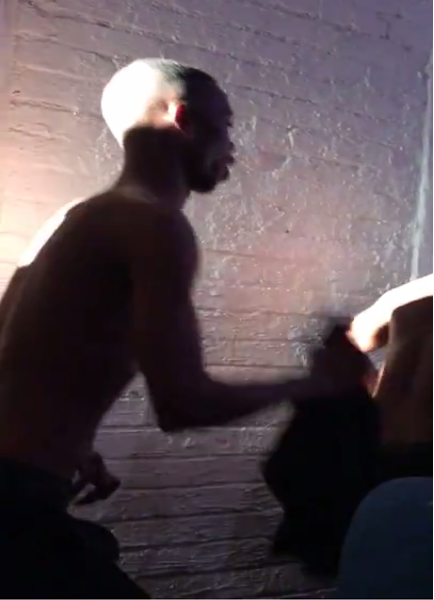
Requiem Request, © Chor. Gregory Maqoma. Dir. Nhlanhla Mahlangu. Iscathamiya choir, Phuphuma Love Minus. The Centre for the Less Good Idea. Johannesburg, South Africa. Video by author, Sept. 11, 2017.
On the evening of my return to New York from South Africa, I attended an event entitled Global HOPE, sponsored by Irina Bokova and UNESCO, which honored heroes in the fight against extremism. It reemphasized to me the importance of art and culture in regard to the history of South Africa and in terms of building confidence for a post-apartheid generation. It reminded me that the fight for peace and stability is intimately tied to our support for art and culture. In South Africa as with the majority of the African continent, where the majority of the population lives in poverty, art must not be the commodity of the elite.
There is a fear that the collector will cannibalize these artists and their works. If cannibalism represents, as has been suggested by Roger Davis, “the appetites of the West as projected on to the other” and “one of the true horrors of the cannibal is the disproportion of the West’s appetite”, then the increasing access of the West to consume African art may poses inherent risks. In his writing on cultural commodification, Paul Wright discusses the ways in which capitalism chews up and spits out culture, writing that: “more than 100 years ago, Karl Marx wrote about capitalism’s ability to turn everything into a commodity…one aspect of cultural commodification is its ability to co-opt, neutralize, and render powerless any challenges to the economic and political status quo. In this way, cultural hegemony is enforced.” The fear in this case is that the Western Market will use Zeitz MOCAA as a vehicle to commodify contemporary African art, neutralizing its healing and transformative power and reducing its value to a dollar amount. The struggle is for this generation of born free artists to link to their tradition and recognize the power of African art to confront and subvert the harmful power dynamics of a post-colonial legacy.
To fully realize its potential, Zeitz MOCAA ought be an agent to transform the European concept of Africa, and its subjective Eurocentric view of primitive people, to support an objective global concept and not one fueled by a Eurocentric model. Geers states that: “African Art is a Philosophy that thrives in the smallest village, in the most remote part of Africa, where living traditions of art remain deeply rooted in the community and art, the environment and the embodiment of sacred beliefs. Art is not disconnected from its context and remains a vital force of spirit. African Art is Philosophy cannot separate the mask from the masked, cannot take the dancer out from the dance which cannot be stopped until the rite has been written. The masquerade cannot be read outside of the community upon whose faith it emanates from.”
“Once an object or work of art, any work of art, is isolated from its context, the viewer will add their own layers of reading and fill in the gaps of understanding with their own fears and desires. It was for this reason that the power objects known as ‘Nkisi,’ or ‘Spirit,’ was referred to by Europeans by the term ‘fetish.'”
The tremendous support, sense of community, and shared vision I experienced from South African galleries to transform Africa’s nascent arts culture into a cohesive whole that exceeds the sum of its individual fairs, galleries and institutions by reaching out to publics from across the globe to build a cultural identity for contemporary African artists and audiences is heartwarming.
If Zeitz MOCAA is to fulfill its promise to be a leading voice for contemporary African art, it bodes well to hear the “less good idea” and listen to the voices of the ancestors.
…Now while the Africa of despotism is dying – it is the agony of a pitiable princess,
Just like Europe to whom she is connected through the
naval.
Now turn your immobile eyes towards your children who
have been called
And who sacrifice their lives like the poor man his last garment
So that hereafter we may cry ‘here’ at the rebirth of the world being the leaven that the white flour needs.
For who else would teach rhythm to the world that has
died of machines and cannons?
For who else should ejaculate the cry of joy, that arouses the dead and the wise in a new dawn?
Say, who else could return the memory of life to men with a torn hope?
They call us cotton heads, and coffee men, and oily men.
They call us men of death.
But we are the men of the dance whose feet only gain
power when they beat the hard soil.
-from Prayer to Masks by Léopold Sédar Senghor
**Zanele Muholi, William Kentridge, Mohau Modisakeng, Wangechi Mutu, Nicolas Hlobo, and Kendell Geers, among many others will be in New York for Performa 17, from November 1-19. http://17.performa-arts.org/calendar.
[1] Barbara T. Hoffman is a preeminent international art lawyer with an undergraduate degree in art history. She has been a passionate follower of the contemporary art scene for years and a regular attendee at the Venice Biennale since the early 1980’s. She has written frequently on law, art and politics for a variety of publications and is a member of the International Association of Art Critics as well as the attorney for AICA USA. She serves on the Board of Performa, the visual Performance Biennale, found the Washington State Volunteer Lawyers for the Arts and is on MoMA’s Contemporary Arts Council and Friends of Education. She serves on the board of several artist endowed foundations and advises museums and artist foundations on issues of governance, including board development and conflict of interest.
[2] http://www.oneartnation.com/the-57th-venice-biennale-2017-getting-to-the-art-of-the-matter/


